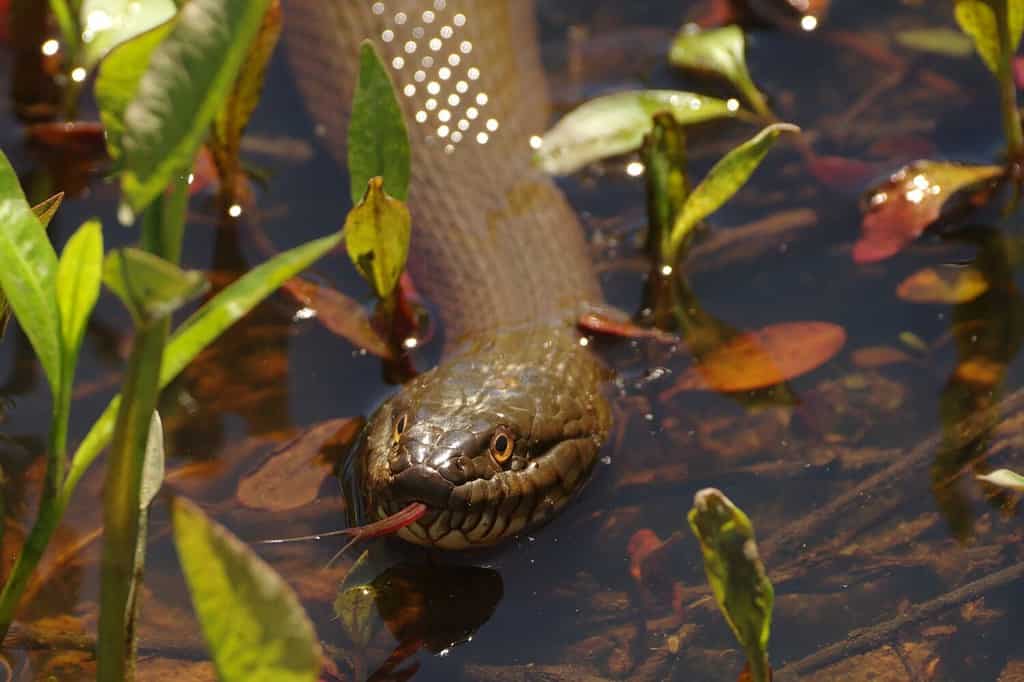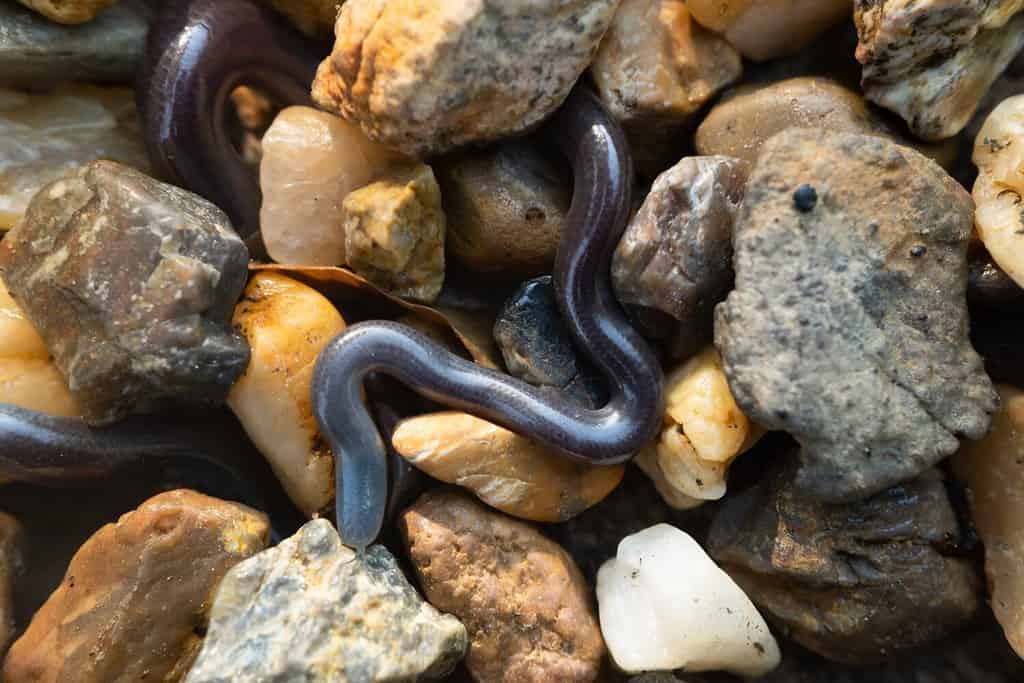Most of us know snakes did not lose their legs overnight. It was a long, slow evolutionary process over many thousands of years. But the reality of it is a lot more complicated! Specifically, there are two main theories as to how and why snakes lost their legs in the first place. Read on to discover all the details below. We’ll also cover some interesting facts about when and why these unique reptiles shifted from walking to slithering. Finally, we’ll discuss whether or not any snakes still have legs today and why!
Theory 1: Snakes Lost Their Legs to Live in Water

The most common theory for many years involved snakes losing their legs to better adapt to an aquatic lifestyle.
©Philip Yabut/Shutterstock.com
Snakes first showed up in the fossil record around 150 million years ago. They branched off and evolved from their lizard ancestors, but how and why is still heavily debated. Before the mid-2010s, the prevailing theory was how and why snakes lost their legs so they could better adapt to a more aquatic lifestyle. As far as we know, they likely began to lose their limbs around 100 million years ago.
However, more recent research and newly-discovered fossils give experts a more detailed picture of how and why the process occurred.
One important detail is in the genetic development of snakes. A gene called Sonic Hedgehog (named for the popular video game series) controls the growth of many animals’ limbs, including those of reptiles. Additionally, certain DNA components called “enhancers” that help to control when genes like Sonic Hedgehog turn on and off.
At some point during snakes’ evolution, the enhancers for limbs disappeared from their genetic makeup. Bizarrely, though, the Sonic Hedgehog gene does “turn on” briefly in the embryos of boas and pythons. Notably, these are the most ancient living snakes today. Before any limbs can develop, though, the gene turns back off.
For many years, researchers believed this happened to allow snakes to enter water and swim rather than walk. After all, an elongated body with no limbs would allow for a more streamlined, hydrodynamic body plan. This body plan would be similar to that of an eel. However, this theory has largely fallen out of favor for the next theory we’ll cover below.
Theory 2: Snakes Lost Their Legs to Live Underground

Snakes like the Brahminy
blind snake
are well-adapted to life underground. Ancient snakes most likely lost their limbs to navigate a fossorial environment better.
©frank60/Shutterstock.com
The most commonly accepted theory today is how and why snakes lost their legs so they could better adapt to living on land and underground. Though many experts believed snakes lost their limbs so they could swim, a shift occurred in 2016 after a fossil of a 90 million-year-old snake, Dinilysia patagonica, was more thoroughly studied.
This ancient serpent’s skull proved to be a critical piece in the puzzle, the now-missing limbs of snakes. By taking CT scans of the skull, researchers found it had a unique inner ear shape, specifically the vestibule. The vestibule helps to perceive movement and direction, provides better balance, and helps an animal’s body navigate its environment.
Fossorial snakes (meaning they live underground) have very large vestibules to hear more and better facilitate navigating an underground habitat. Modern snakes that are not burrowers have much smaller, less prominent vestibules by comparison.
Notably, Dinilysia patagonica was the giant burrowing snake to ever exist, the first snake to completely lack limbs, and a close relative to today’s snakes. It emerged around 85 million years ago. Because this now-extinct snake ancestor had a distinctly larger vestibule, modern snakes likely lost their limbs to live underground.
This theory gets even more interesting if we consider other fossils from around the same time. For example, Pachyrhachis problematicus, a 98-million-year-old snake that mainly lived in water, had tiny back limbs that served no function. Because its hips were too small to support them, they were likely useless for swimming.
Another snake that existed around the same time, Najash rionegrina, a 92-million-year-old species, also had a tiny pair of hind limbs. These were likely used as “claspers” for mating. It’s recently become more apparent that snakes lost their limbs over time to traverse land and a fossorial environment better.
Do Any Snakes Still Have Legs Today?

Snakes like the boa constrictor still possess tiny hind limb bones, though these are mostly useless.
©iStock.com/Michael McDonald
Since snakes lost their legs many tens of millions of years ago, no species today still have limbs. However, it’s worth noting that snakes such as boas and pythons (the oldest living snakes today) have remnants of hind leg bones near their tails!
Unfortunately, these leg bones are almost entirely useless. They are far too small and weak to be useful for locomotion. Still, some species use them for mating. Specifically, males often use their hind leg bones (like Najash rionegrina mentioned above) to grab onto their partner better for success and stability while mating. Other than this, no modern snakes have legs of any kind.
The photo featured at the top of this post is © Philip Yabut/Shutterstock.com
Discover the "Monster" Snake 5X Bigger than an Anaconda
Every day A-Z Animals sends out some of the most incredible facts in the world from our free newsletter. Want to discover the 10 most beautiful snakes in the world, a "snake island" where you're never more than 3 feet from danger, or a "monster" snake 5X larger than an anaconda? Then sign up right now and you'll start receiving our daily newsletter absolutely free.
Thank you for reading! Have some feedback for us? Contact the AZ Animals editorial team.







